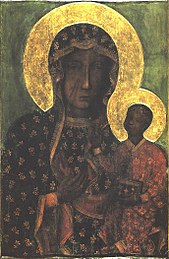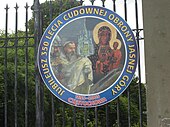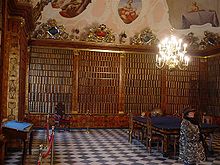Jasna Góra (Częstochowa)
Jasna Góra (German: Klarenberg or Heller Berg , Latin: Clarus Mons ) is one of the most important pilgrimage sites of the Roman Catholic Church in the middle of the city of Częstochowa (Czestochowa) in the Silesian Voivodeship . Here in the Pauline monastery with the miraculous icon of the Black Madonna of Czestochowa (the so-called Queen of Poland) is the largest Marian shrine in Central Europe , which is also the most valuable national shrine of Poles and is visited by around 3 to 4 million believers every year.
history
Between 1367 and 1372 called Duke Władysław II. As governor of the Hungarian king I. Ludwig Hungarian Pauline monks in the Kingdom of Poland . They named the 293 m high bright mountain , based on their ancestral monastery on the bright mountain in Buda, simply in Polish Jasna Góra .
In 1382 the prince in Częstochowa handed over a small church to the Polish Empire, which was consecrated to the Virgin Mary, and brought the miraculous image of the Black Madonna from the Ukrainian city of Bels . The growing fame of this picture meant that Jasna Góra became the destination of many pilgrims who gave numerous and valuable votive offerings.
In 1430 the monastery was attacked and the image of the Virgin was badly damaged. The picture was supposed to be restored in Krakow at the court of King Władysław II Jagiełło , but this did not succeed because the painters tried to apply tempera paints to an encaustic painting . Therefore, the wax was removed and a true copy of the picture was created. The marks of the sword blows were scratched in memory. The desecration and "restoration" of the picture increased the fame of the pilgrimage site.
In 1621, the Polish king Władysław IV. Wasa began building defensive structures around the monastery complex. The sanctuary became a "fortress of Mary" ("fortalitium marianum").
Siege during the Swedish Flood in 1655
In the winter of 1655, during the Second Northern War , Jasna Góra survived a month-long siege by 3000 regular Swedish soldiers (see Siege of Jasna Góra ). There were only about 260 defense lawyers headed by Prior Father Augustin Kordecki, whereupon the Swedes withdrew after 40 days. This victory was attributed to the protection of the Mother of God herself. After this event all of Poland rose to fight the Swedish invaders. Nevertheless, the chain of defeats did not end at first, the turn of the war only came through an alliance with the Muslim Crimean Khan and his Tatar auxiliaries, of all things.
In 1656 the Polish King John II Casimir made a solemn pledge in Lemberg Cathedral and placed all the countries of his kingdom under the protection of the Mother of God. Jasna Góra thus became a symbol of religious and political freedom for all Poles. Especially during the later partitions of Poland , Jasna Góra was the unifying element for the divided nation.
Battle during the Lubomirski Rebellion in 1665
During the Lubomirski rebellion there was a battle in Jasna Góra in 1665.
Siege during the Second Swedish Invasion 1702–1709
During the Third Northern War , Jasna Góra was again the scene of a Swedish invasion. This time the commandant of the fortress was the prior of the Pauline monastery Euzebiusz Najman. From August 13 to 15, 1702 approx. 9,000 Swedish soldiers marched under the command of General Nils Gyllenstierna (1648–1720) from Szczecin to Kraków . After a few days, the Swedes tried to take the fortress with the next attempt and marched to Kraków. At the beginning of January 1704 the new prior Jasna Góras Innocenty Piskorski refused to General Rehnskölda to hand over the fortress to the Swedes.
The crowning glory of the picture
Until 1770 Jasna Góra was not a place of bloody combat operations. By virtue of the law of 1716 by Pope Clement XI. took Bishop Christoph Andreas Johann Szembek on 8 September 1717 coronation of the Black Madonna . This was the second coronation ceremony of an image of grace on the Polish nation (the first took place in 1651 in Warsaw's Kościół Ojców Pijarów ). According to historians, the coronation ceremony was performed with 200,000 people on site.
Siege during the Confederation of Bar
From September 10, 1770 to August 18, 1772, the Bar Confederation, under the leadership of Kazimierz Pułaski, successfully defended the monastery against the Russians. However, when it collapsed in August 1772 and Poland-Lithuania's last King Stanisław August Poniatowski announced the surrender of Jasna Góra, the last Polish fortress, the monastery fell into Russian hands. Alois Friedrich von Brühl created the corps of engineers that partially rebuilt the fortress in 1783.
Under Russian occupation after 1798
The period under the rule of the Russian Empire was a time when the oppression of the monastery worsened: the number of monks was limited and good land was occupied. On October 24, 1909, the Pułaski painting was desecrated by the Pauline Damazy Macoch. On May 22, 1910, the so-called Millennium Crown was repeatedly crowned , which was highly praised by Pope Pius X. In addition to the crowns, the painting received a new coral red. Jasna Góra avoided the First World War under the occupation of Austria-Hungary from April 26, 1915 to November 4, 1918.
During the Second Polish Republic 1920–1939
The interwar period saw the reform of this monastery and the restoration of the Black Madonna (1920).
During the Second World War 1939–1945
In the first days of the war there was a report in the Polish press that the air force had attacked the monastery. However, this information turned out to be incorrect. During the Second World War , some monastery rooms were occupied by German troops from September 3, 1939 to January 16, 1945. The icon on the main altar was replaced by a copy and the original was hidden in the monastery library. During this time Jasna Góra was a refuge for partisans, but also Jews.
In the People's Republic
On August 26, 1956 in Jasna Góra with around 1,000,000 Catholics , the Jasnogórskie Śluby Narodu Polskiego (Jasnogórski Vows to the Polish Nation) , written by Stefan Wyszyński , was prayed for the first time for his release from prison.
After 1989
John Paul II visited Jasna Góra 6 times: in 1979, 1983, 1987, 1991 (during the VI World Youth Day ), 1997 and 1999. In 2006 Pope Benedict XVI visited Jasna Góra . Jasna Gora.
In 2005 the 350th anniversary of the defense of Jasna Góra was celebrated. For this reason u. a. organized:
- on May 3rd a battle drama, performed by the Bractwo Kurkowe Grodu Jelcz-Laskowice
- on September 11th a big anniversary concert, a performance of Częstochowska Victoria with the participation of Polish TV , in which u. a. Participants: Krystyna Feldman , Anna Seniuk , Daniel Olbrychski , Maciej Kozłowski , Paweł Kukiz , Natalia Kukulska , Arka Noego and actors from the Adam Mickiewicz Theater in Częstochowa
Fortress of Mary on the Jasna Góra
A : Lubomirski Gate / entrance from the parking lot;
B : Gate of Matka Boska Królowa Polska;
C : Gate of Matka Boska Bolesna;
D : Jagiellonian Gate;
E : Mariensaal;
Q : Royal Bastion;
G : Father Augustin Kordecki monument;
H : treasury;
I : Altar of the Basilica of the Assumption of Mary with the miraculous image of the Black Madonna ;
J : Trinity Bastion;
K : John Paul II monument;
L : Morsztyn bastion;
M : John Paul II Gate / entrance from the parking lot;
N : Bastion of Saint Barbara;
O : Musikantenhaus;
P : Upper Room ;
R : garden;
S : Jabłonowski Chapel (Chapel of the Heart of the Lord Jesus);
T : Dönhoff Chapel;
U : entrance to the tower;
V : Chapel of St. Anthony ;
W : Royal Apartments;
X : Basilica of the Assumption of the Virgin Mary and the Finding of the Holy Cross;
Y : sacristy;
Z : Chapel of the Adoration of the Most Holy Sacrament (above the Chapel of the Black Madonna);
a : knight's hall ;
b : monastery garden ;
c : refectory and library;
d, e : monastery ;
f : water storage;
g : Museum of the 600th anniversary;
h : Arsenal with Radio Jasna Góra;
i : farm yard;
j : main courtyard;
k : Cardinal Stefan Wyszyński monument.
A statue of Pope John Paul II was built in his honor.
The fortress extends over an area of around 5 hectares. The fortified part of the complex - built from the 15th century (purple in the picture) to the 20th century - is surrounded by a park to the north, west and south-west.
The representative main entrance is in the south and a large open space for mass events in the east.
To the west is the pilgrimage center with accommodation, restaurants and parking spaces.
The monastery tower of the fortress of Mary, with its height of 106 m, can already be seen from several kilometers away. It serves as a bell tower, but also as an antenna support for the radio station of the fortress of Mary.
basilica
The church has been a basilica since 1906. Before that it was called the Church of the Holy Cross and the Visitation of Our Lady . It has existed in its current form since the beginning of the 18th century, when it was rebuilt as a three-aisled basilica in the Baroque style after the fire of 1690.
organ
The organ was rebuilt in 1956 by the organ builder Stefan Truszczyński from Warsaw.
From 1721 to 1725 Adam Horatio Casparini had built an organ that was dismantled by the Rieger organ building company before 1914 with the aim of building a new one, which however never took place. In 1914 Dominik Biernacki built a 13-part instrument that is now in the Pauline Church in Warsaw.
When the organ was rebuilt in 1956, parts of the organ in the Centennial Hall in Breslau were used. Today the instrument has 85 registers (and 4 transmitted registers in the pedal) on four manual works and pedal . The playing and stop actions are electro-pneumatic. The organ can be played together with a second organ, with a total of 105 stops.
The disposition of the main organ with 85 registers is
|
|
|
|
|
||||||||||||||||||||||||||||||||||||||||||||||||||||||||||||||||||||||||||||||||||||||||||||||||||||||||||||||||||||||||||||||||||||||||||||||||||||||||||||||||||||||||||||||||||||||||||||
- Coupling: II / I, III / I; IV / I, III / II, IV / II, IV / III, I / P, II / P, III / P, IV / P
Chapel of the Miraculous Black Madonna
The Chapel of the Miraculous Black Madonna , also called Kaplica Cudownego Obrazu (Chapel of the Miraculous Image ), is located north of the basilica on the eastern edge of the fortress. It has its own courtyard in front of it.
Monastery library
The hall, where the monastery library is now located, is the second place where Jasna Góra's collection of books is kept. Previously, it was on the lower floors of the monastery tower (now: Kaplica Pamięci Narodu ).
Radio Jasna Góra
The Catholic radio station of the Marian pilgrimage site, Radio Jasna Góra , has been broadcasting daily with interruptions on the VHF frequency 100.6 MHz since March 25, 1995. Are transmitted u. a. the holy masses from the basilica.
statistics
According to the Jasna Góra press office, around 3.5 million pilgrims and visitors from 66 different countries came to the shrine in 2004. Including 139 cardinals, archbishops and bishops from 29 different states, as well as 11,976 priests from 69 different states. Holy Communion was given 1,920,000 times.
Knight of Jasna Góra, Czestochowa
After an unsuccessful 40-day siege by the Swedish king Karl X. Gustav , Pope Urban VIII handed over to King Władysław IV Wasa the charter for the order of the knightly order of the Blessed Mother, the ORDO EQUESTRIS IMMACULATAE DEIPARAE VIRGINIS, presumably in the 15th century (Order of the Knights of the Immaculate Theotokos). The knight order of the Madonna of Jasna Góra, Czestochowa , revived in 1991 and recognized by church law in 1998 , may only belong to 72 people. On October 23, 1998, Pope John Paul II personally took over the patronage of the Order.
References
literature
- Werner Kunzenmann : Czestochowa. Jasna Góra Cze̜stochowa. The pilgrimage to the Black Madonna on the Hellen Berge . Veritas-Verlag, Linz u. a. 1983, ISBN 3-85329-365-4 .
- Mirosław Zwoliński: Przewodnik po Częstochowie , Częstochowa 1997, pp. 87–112 (Polish).
- Jan Pach, Włodzimierz Robak, Jerzy Tomziński: Jasna Góra. Sanctuary of Matki Bożejźź. Przewodnik . Wydawnictwo Zakonu Paulinów, Częstochowa 2001 (Polish).
- Czesław Ryszka: W Maryjnej Twierdzy . Jubileusz zwycięskiej Obrony Jasnej Góry, Urząd Miasta Częstochowy 2013 (Polish).
- Paweł Podejko: Kapela wokalno-instrumentalna Paulinów na Jasnej Górze PWM 1977 (Polish).
Web links
Individual evidence
- ↑ Góra, Katolicka Agencja Informacyjna, July 24, 2013
- ↑ Information about the organ (Polish) no longer available
- ↑ Bazylika Znalezienia Krzyża Świętego i Narodzenia NMP (Jasna Góra) - organy w nawie głównej with related dispositions (Polish)
- ^ Website Ordo Equestris Immaculatae Virginis Claromontanae , accessed on April 13, 2015
- ↑ Michael Hesemann: Knight of the Mother of God of Jasna Gora , November 10, 2013, accessed on April 13, 2015
Coordinates: 50 ° 48 ′ 45 ″ N , 19 ° 5 ′ 50 ″ E












